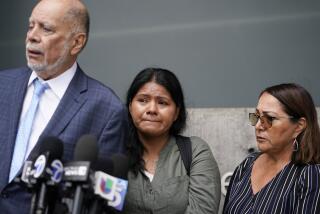Their Eyes Glaze Over Pedantic Anti-Drug Slogans and Campaigns Seen by County Students as Counterproductive
- Share via
More than 300 white crosses were planted in late October next to the Santa Ana Freeway in Irvine as a symbol of Sheriff-Coroner Brad Gates’ anti-drug program and Red Ribbon Week.
Every year, children of all ages attend assemblies, seminars and lectures on drug prevention. The “Be Smart, Don’t Start” slogan is repeated endlessly to millions of receptive elementary school children and semi-attentive teen-agers.
Many high school-aged students are tired of hearing the same old story: Drugs are bad, drugs kill, drugs are suicide. Most teen-agers already know those things, and telling them time and time again may, instead, turn them off to the importance of the message.
“I think it (Red Ribbon Week) is a waste of everyone’s time,” said Itai Chazan, a 15-year-old sophomore at Laguna Beach High School. “Almost everybody ignores it. If people want to do drugs, then telling them (not to) over and over isn’t going to help.
“It’s ignorant of people to try and stop other people from doing drugs. If people want to do it, then nothing’s going to change their mind unless they decide for themselves. It’s their choice; it’s their life.”
Red Ribbon Week seems to be the answer to the lack of communication about drug awareness, or so the adults who organized the event believe.
The 1-week, national campaign against drug abuse began last year, when students were asked to wear small red ribbons to symbolize the anti-drug effort.
But do gimmicks such as red ribbons mean anything?
“I have a friend who is a drug user,” a sophomore at Capistrano Valley High School said. “I hoped that by listening to all of the bad effects of drugs this week, she would stop. But nothing changed.”
Susie Cheatley, 16, a junior at Laguna Beach, said: “I feel that Red Ribbon Week was a waste of money. As I sat in the assembly, I noticed that all the people who I knew had drug problems laughed, and so did the people without drug problems. The program didn’t help anyone.”
“Everyone wore the ribbons, but no one cared about the significance,” said Sarah Channels, a 14-year-old freshman at Laguna Beach. “It was a new fad for a week.”
James deBoom, president of the Newport-Mesa Unified School District’s board of education, somewhat agreed: “The elementary kids seem to be very receptive and enthusiastic. Most high school students don’t take the program seriously.”
Even former Olympic gymnastics champion Peter Vidmar’s appearance at a rally at Newport Harbor High School didn’t seem to change the attitudes of many students, deBoom said.
Greg Smith, a member of the Irvine Unified School District board, said a change is necessary: “If you repeatedly deliver a message, then you have to change the way you present it. Otherwise, it has no effect.”
Some, however, believe Red Ribbon Week is fine just as it is.
“I think it was a good idea,” said Jenny Stice, a 14-year-old freshman at Capistrano Valley. “Many people participated in the activities around school. I think it benefited everyone in one way or another.”
Shelly Lane, another 14-year-old freshman at Capistrano Valley, said: “I hope it made people think about not doing drugs and taught them to make the right choices.”
Rob Richardson, president of the Santa Ana Unified School District board of education, said of Red Ribbon Week: “I believe that it made a lot of students more aware of the results from using drugs. I was impressed by the number of students involved.
“I think that if a message is important, then it needs to be repeated for as long as it takes to get the point across.”
Megan Chesley agreed. The 15-year-old Laguna Beach sophomore said: “Red Ribbon Week should be emphasized more throughout the school year because after a week or two, everyone forgets about the seriousness of it all.”
But are the Red Ribbon efforts aimed at the right people or even in the right direction?
Instead of presenting the “Just Say No” campaign--or this year’s equivalent: “Hugs, Not Drugs”--adults might consider offering a more important program: how to quit drugs. They should also remember that teen-agers are not children.
“Many times, parents make more decisions for their 15-year-old than they do for their 5-year-old,” said Joyce Vittario, who has a 15-year-old attending Capistrano Valley. “It is important to let them make their own decisions, like drugs and the decision to avoid them. By constantly telling them ‘not to,’ they are more liable to do it just to disobey their parents.”
Megan Weiss, a 14-year-old freshman at Laguna Beach, said of Red Ribbon Week: “It was a very good effort, but it had little effect on the students. They’d rather listen to peers than assemblies. Many teens are rebellious toward their parents and listening to them preach just makes it worse.”
Then how do you persuade somebody to quit using drugs if they don’t want to?
“It’s almost impossible,” said John Christenson, director of Counterpoint, a drug and alcohol rehabilitation program at Community Psychiatric Care Hospital in Laguna Hills. Christenson said the person must make the choice on his own, but when that choice is made, he needs to immediately check into a rehabilitation program.
So is there any point at all to Red Ribbon Week?
“The only problem is that we’ve heard it too many times before,” said J.T. Klingenmeier, a 15-year-old sophomore at Laguna Beach. “Now, it’s just an excuse to get out of class.”
More to Read
Sign up for Essential California
The most important California stories and recommendations in your inbox every morning.
You may occasionally receive promotional content from the Los Angeles Times.










